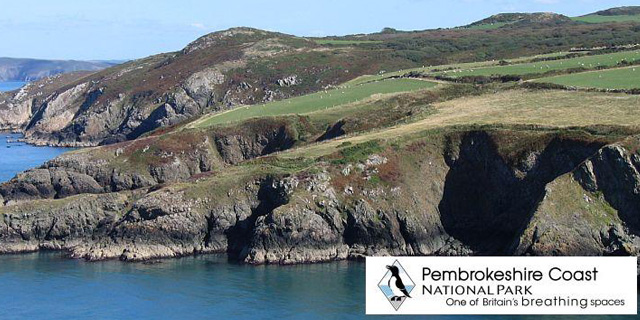CK Planning recently obtained full planning permission from the Pembrokeshire Coast National Park for Mr David Ward to operate a commercial car repair garage in St Davids. Since 2003 the garage had been operating under a number of temporary consents and following professional advice and support from Chris Kimpton of CK Planning a full planning application was prepared and lodged with the National Park. Without full planning permission Mr Ward was unable to grow and develop his business as the temporary consents hindered his ability to obtain the necessary capital investment for staff training in the use of ‘hi-tec’ car systems, the repair and maintenance of electric/hybrid cars, the acquisition of specialist tools and diagnostic equipment and the establishment of an MOT station. Mr Ward comments that ‘without CK Planning’s expert planning experience, knowledge and guidance my business would have been unable to grow – as it is I already employ two local people and can now plan to offer another full time mechanics job to someone else living...
Read MorePembrokeshire Planning ‘Classics’
Classic Pembrokeshire Planning responses You can have a holiday home in rural Pembrokeshire but not a family home because there is no bus service. A business has been operating for 42 years and the ageing owners, who are in their 70’s, want to retire and allow their daughter to take it over and live in a former cottage on the site – they were told sorry but due to your ill health the business isn’t viable anymore and anyway she can go and live in the nearest village (where house prices are 3.5 times the cost of renovating the farm cottage). A caravan has on a site for 40 years but suddenly the planners don’t like it and it has to go – the caravan is owned by a 75 yr old man and the consent is personal to him so once he stops using it or passes away it has to go anyway. The fenestration in a proposed new house was deemed to be incongruous with the rest of the street – the rest of the street comprised every conceivable type of window shape, material and size that could ever be imagined. We are not going to support that application for a wind turbine because the owner wants to make money out of it. Our policy promotes affordable homes in rural areas and the open countryside (where there are no buses, schools, shops, doctors, etc, etc) ‘I don’t like that design’ – ‘Why?’ (pause for thought) – ‘Because I don’t.’ ‘That (small) extension will spoil the whole character of the cottage’ – said whilst standing looking at a similar neighbouring cottage that had been extended 3 times and increased in size by 150%. Wind farm proposals submitted by larger companies appear to be profit motivated. To a developer – ‘Why should I support this proposal only to make you more money’. Planning Inspector to planner – ‘Could you point out where the Coast Path is in relation to the appeal site’ Planner straight away points to the east ( it was to the west) Objectors letter to a wind turbine ‘The noise will be even worse than his...
Read MoreGetting Planning Right in Pembrokeshire
To get a Pembrokeshire planning application through the system in Pembrokeshire now requires a considerable amount of professional expertise and assistance. There is, for a start, a whole raft of requirements to meet even before a planning application can be what is termed ‘ validated’ – that means the scope of material submitted in support of the application must meet a list of standard requirements. Failure to meet any of the listed requirements will result in a request from the planning authority to supply that information within a set number of days (normally 14 working days) and if the stated timeline is not met the applicant can then either withdraw the application (and start all over again) or have it cancelled and returned by the planning authority. These planning requirements (or criteria) are clearly and comprehensively outlined in Supplementary Planning Guidance (SPG) documents which are available from the local planning departments and their web-sites in Pembrokeshire. If an applicant disagrees that more information is required written justification can be put to the planning department setting out the reasons why that specific information is not appropriate in that case. If the planners agree that the information is not necessary to determine the application it will be validated. If an applicant does not agree with the planners requirement for further information there is a right to challenge the decision not to validate an application. This is a right of appeal under Section 78 of the Town and Country Planning Act 1990, the ground being non-determination of the application within the 8-week determination period. However, a strong word of caution here as such an appeal would have to be lodged before the application is returned or cancelled. Also, the appeal process can take around 10 weeks for a decision to be issued and that is essentially another 2.5 months of ‘dead-time’ time taken out of a project. For expert guidance on planning application preparation, presentation and processing ckplanning is the areas foremost professional planning consultant when it comes to getting a planning application validated in Pembrokeshire or...
Read MorePembrokeshire Coast National Park Planning Policy Alert
Site accessibility is now being used by Pembrokeshire Coast National Park planning officers as a reason to refuse new development and outbuilding conversions. Policy 7 of the Local Development Plan (LDP) contains qualifying criteria which refers to ‘accessibility to the Centres identified in the hierarchy’. This requirement has been interpreted as a site having to be within 1km of a named Centre identified in the LDP, or the site being more than 1km away from a centre but within 1km of a bus service (however, this is where more qualifying criteria come in!) or the site is within 1km of a bus route with 5 or more return journeys a day. However, if a site is within 1km of a bus route with less than 5 return journeys a day it is deemed appropriate for holiday letting or, incredibly, affordable housing. Further ‘concessions’ are made for affordable housing if an application involves a building of architectural or historic interest or is simply for affordable housing, in which case the site does not have to be accessible. What we are therefore now seeing is a policy presumption being pursued by planning officers against much needed open market housing in the Pembrokeshire National Park, in favour of holiday homes and, more amazingly, affordable homes in isolated locations. Surely the whole idea of affordable home provision is to build close to shops, services, schools, bus routes, doctors etc so that the occupants are not further disadvantaged by finding themselves in a totally isolated rural location. Yet another example of the way planners in Pembrokeshire are working against the economic and social well-being of the areas...
Read MorePlanning for Wind Turbines in Pembrokeshire
Obtaining planning permission for a wind turbine between 15m and 50m in height is getting increasingly more difficult. Pembrokeshire County Council and Pembrokeshire Coast National Park planning officers are now requesting much more detailed landscape assessments for what were, until recently, considered to be relatively small wind turbines. Initial, informal advice was that for a wind turbine under 30m a landscape impact assessment was not required. This was soon superseded when Pembrokeshire County Council planners commissioned a report to provide guidelines for landscape and visual impact assessment requirements. This report was published in August 2012 and Table 2 contains specific guidance on the levels of assessment required for three categories of wind turbine size – less than 15m – between 15m and 50m – and over 50m. At present most wind turbine proposals are falling within the 15m to 50m category. Planning for Wind Turbines In summary, a wind turbine of between 15m and 50m will require the following levels of assessment:- Wireframes and/or photomontages for a limited number of key viewpoints; A consideration of LANDMAP information and potential the Seascape Assessment of Wales; Consideration of the landscape and visual amenity of the are wherein the wind turbine is to be located; A Cumulative Impact assessment taking into account all other existing, consented and proposed wind turbines within a 15km to 17.km radius – commonly referred to as the Zone of Theoretical Visibility (or ZTV). To satisfy the above information requirements ckplanning ltd in association with Ynni Ltd now have their own software and specialist camera equipment which enables us to produce wireframes, photomontages and ZTV’s. We also have the GPS Co-ordinates for every existing, consented and proposed wind turbine in Pembrokeshire. Our combined planning skills allowed us to meet a short-notice request from Pembrokeshire County Council planning officers for a detailed landscape impact assessment from one of our clients, Mr Chris Downs of Hayscastle, whose application for a Xzeres 442SR Wind Turbine was about to be refused planning permission. Mr Downs has now been granted planning permission for his wind turbine, which will be the second one on his farm. The level of expert, cost-effective landscape and planning...
Read More




